
 |
UNLIMITED AIR RACING - RENO 2017
Text and Photos by Dan Whitney
Published 20180206
Air Racing at Reno 2017 was Great! Warbirds racing in the Unlimited Division increased from 11 in 2016 to 18! This is a big step in the right direction, particularly when it is realized that eight were piloted by “rookies.” There were sufficient Unlimited racers that heats were held every day for the Bronze, Silver and Gold class racers.
The weather was again some of the best ever, and in addition, it was a safe week, excepting two Sports class airplanes that had a mid-air collision when “coming down the chute,” at the start of a race. Both landed safely, without further incident.
The Big Picture
This year’s Unlimited field included nine P-51 Mustangs, four Sea Furys, a Corsair, a Wildcat, one P-40E, a Spitfire and an Allison powered Yak (that came all the way from New Zealand!). This year the highly modified P-51 Strega returned, after missing the 2016 races for want of an engine overhaul, to challenge the equally unique Voodoo. Voodoo had just come from Idaho, where she established a new Absolute Propeller-Driven Piston Powered 3 km C-1e speed record at 531.53 mph!
The Unlimited Class is the big attraction at Reno – everyone loves to see the Warbirds ‘get it on’, particularly the highly modified racers like Strega, Voodoo and Dreadnaught. Other than that, the “stock” Warbirds are extremely attractive, and competitive within their own ranks, it just that they are 100-150 mph “slower.” But they do put on a good show.
Most of the Unlimiteds were individually owned, however the Sanders Brothers brought their three Sea Furys (though the brothers themselves did not pilot racers this year), the Planes of Fame Museum at Chino brought their T-33 pace plane and two Mustangs, and the Texas Flying Legends Museum entered four of the six Warbirds they brought for the Air Show, as racers. This resulted in a lot of very colorful and shapely racers (Corsair, P-40, Spitfire, Wildcat, Mustangs, Sea Furys, Yak) on the course.
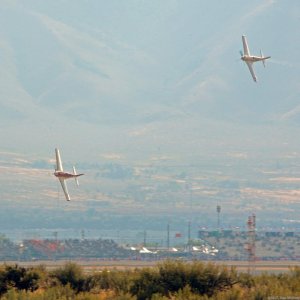 |
| Strega leading Voodoo coming to pylon 2 in the Friday Gold Heat. |
The Races
The length of the Unlimited course was again changed from 8.0851 miles to 7.9107 miles. This was done, not by moving the pylons, but by removing “credit” for the curved path the aircraft actually flys, to simply the straight line distances between pylons. Of course the aircraft still have to cover the actual ”curved” distance, so the effect was to “slow” the posted speeds by 2.2 %. This factor needs to be considered when comparing this year’s speeds to previous year’s speeds. As such, Strega’s time of 58.752 seconds for the qualifying lap, using the 2016 course, computes as a speed of 495.410 mph, compared to the posted speed of 484.724 mph.
Most of the races are of six laps duration, for a length of 46.99 miles, except on Sunday’s finals, where the Silver is seven laps, 54.90 miles, and the Unlimited Gold race is for eight laps, 62.81 miles. Note: all qualifying and race speeds are tabulated at the end of the article.
Air racing, and the airshow, began Wednesday at noon, following the final Unlimited qualifying session, though the first Unlimiteds did not race until Thursday.
Thursday – Though Thursday is the first day of Unlimited racing, traditionally the Gold Class racers get the day off. This still leaves the Silver and Bronze racers, where some very competitive battles developed among the well matched racers. The first to race was the Bronze Class, which was won by New Zealander Graeme Frew in his Allison V-1710 powered Yak 3M Full Noise with a speed of 308.895 mph. He was closely followed by two P-51 Mustangs, Shanty Irish, the recently fully rebuilt P-51A (ex-Polar Bear), and Bunny, a stock P-51D flown by Mark Moodie. Moodie finished 2nd in the race, however accumulated 36 seconds of penalties which dropped his actual speed of 306.976 mph to 288.152 mph and placed him in third.
Although the speeds in the Bronze heat did not approach 500 mph, Graeme was still able to lap the last three racers, the P-40E, Spitfire and Corsair, which were doing about 250 mph. All the passing made it fun to watch.
The Silver Heat featured five P-51Ds and the stock Centaurus powered TMK 20 Sea Fury, piloted by Mark Watt, who won at 360.479 mph. The competitive flying here was between the Mustangs Speedball Alice and Spam Can, which finished in third and forth respectively with speeds of 317.7 and 315.7 mph. Alan Miller in Little Horse was a Did Not Start, as he was feeling ill.
Friday – The days Unlimited racing started off with seven Bronze heat racers, a fun mix including the four Texas Flying Legends airplanes, Corsair, Warhawk, Spitfire and Wildcat, and three Mustangs, one of which was the Allison powered P-51A. These were all “stock” configured and similarly performing airplanes. John Muszala II won in the highly polished, natural metal, “A” model Mustang, Shanty Irish, at 311.782 mph, some eleven seconds ahead of Tom Nightingale in Bunny, a P-51D that finished at 305.859 mph. The Wildcat finished in third, followed by the Spitfire, P-40E, Mustang and Corsair, all within eight seconds of each other and with speeds near 267 mph. No one was trying to break anything, but they were close and fun to watch coming around the pylons. Mark Murphy replaced Alan Miller in P-51D Little Horse as Alan was still recovering from being sick.
The following Unlimited Silver Heat featured six airplanes, four Mustangs, a Sea Fury and Graeme Frew’s Yak 3M Full Noise. The race was won by Mark Watt in the Sanders Brothers Centaurus powered TMK 20 Sea Fury, #924, at a speed of 358.784 mph. He was closely followed by Robbie Patterson in Wee Willie II, a stock P-51D from the Planes of Fame Museum.
Finally, after a long week of waiting, it was time to see the big boys in the Gold Heat. The highly modified P-51s Strega and Voodoo were joined by three Sea Furys, Dreadnought, Sawbones and Argonaut.
As has become the pattern, Strega and Voodoo were way out in front for the entire race, and in fact both lapped Argonaut in the six lap race. James Consalvi in Strega won at a speed of 487.892 mph, faster than his qualifying speed of 484.724 mph, while Steve Hinton came in second in Voodoo at 476.99 mph. Stevo was taking it somewhat easy as not all was going well within his racer's Merlin. Dreadnought finished third at 418.716 mph, always in position should the “hot rods” up front have to pull out, followed closely by Sawbones at 413.905 mph.
Saturday – The Bronze Heat racers were again the first on the Unlimited program for the day. The heat was won by Mark Moodie in P-51D Bunny at a speed of 306.655 mph. He was followed by the FM-2 Wildcat, piloted by Michael Pfieger, at 282.210 mph. They were followed by four racers that finished within two seconds of each other, and who had been passing each other throughout the race. These were the P-40E, Spitfire, the P-51D Little Horse piloted by a recovered Alan Miller, and the Corsair Whistling Death; all racing in close quarters, lots of fun for both the pilots and spectators!
Sea Fury #924, who won Friday’s Silver Heat, and elected to bump up into the Gold Heat for Saturday. This left a vacancy in Saturday’s Silver Heat, which was filled by Graeme Frew in his Yak Full Noise, even though he had only placed fifth in the Friday Bronze. None of those ahead of him wanted to run in the Silver, so he gladly bumped up. This turned out well for Graeme, as he won the Silver Heat with a speed of 345.377 mph, followed closely by Robbie Patterson in the P-51D Wee Willie II! They were followed by four other Mustangs, including the “A” model.
The Gold Heat was again won by Consalvi in Strega, this time with a speed of 479.124 mph, besting Voodoo who finished in second at 467.423 mph. Stevo and crew still had not resolved the issues with the Merlin, but all hoped they would by the time of the Sunday Gold. The rest of the field was made up of Sea Furys, finishing in their usual order of Dreadnought, Sawbones, Argonaut and #924. Both Argonaut and #924 were lapped by the Mustangs, which was fun to see!
Sunday – The weather, which had been great all week, continued and brought with it a fantastic day, good crowds, and everything set for an exciting conclusion to the 54th Reno National Championship Air Races.
The Bronze Heat got things off in fine form with the recovered Alan Miller bringing Little Horse home in first place at 312.131 mph, some ten mph faster than his qualifying speed, and six seconds ahead of second place, Michael Schiffer in the Corsair. They were followed by the Texas Flying Legends Wildcat, Warhawk and Spitfire.
The Silver Heat was an all Mustang affair! Bunny, who won Saturday’s Bronze Heat when piloted by Mark Moodie, bumped up to today’s Silver, and was now piloted by Tom Nightingale. Although Bunny finished last, it was in the Silver. The Heat was won by Robbie Patterson in the Planes of Fame Wee Willie II at a speed of 337.310 mph. He was closely followed by the other Planes of Fame Mustang, Spam Can, piloted by John Maloney at a speed of 335.506 mph. John Muszala II was third in the Allison powered P-51A Shanty Irish with a speed of 319.644 mph. He was followed by two well match P-51Ds, Speedball Alice and Sparky/Blondie who finished at 312.494 and 312.145 mph respectively, only 0.7 seconds apart after the seven lap 54.9 mile race.
Finally, it’s time for the eight lap, 62.81 mile, Unlimited Gold! Seven racers launched: P-51s Strega and Voodoo, followed by four Sea Furys, Dreadnought, Sawbones, Argonaut and #924, and Graeme Frew in his Allison powered Yak 3M Full Noise. No one could remember the last time an Allison was in the Gold final.
This was the race everyone had been anticipating all week! Had Steve been holding Voodoo (the world’s fastest piston/propeller airplane) back? Had Consalvi run out his Merlin during qualifying and the previous two days while staying ahead of Voodoo? As they came down the chute Voodoo took the lead and held it while being challenged by Strega through the first seven laps; Consalvi flew high the whole race, while Hinton kept Voodoo on track down low. On laps 5 and 6 it appeared that Strega was closing the gap, which was never more than 5-600 feet. Then on the last lap the two approached a lapped Sea Fury, Consalvi went high on the turn at the far end of the course and came down just in front of Voodoo – where he remained for the rest of the race, winning by 0.582 seconds with a speed of 481.340 mph, 410 feet ahead of Voodoo.
Complicating the race was the wide range of speeds and the duration. At the finish line Strega and Voodoo passed and lapped Dreadnought, who was finishing lap seven, Earlier they had lapped Sea Furys Sawbones and Argonaut, and twice lapped the Centaurus powered Sea Fury #924 and Graeme Frew’s Yak Full Noise. The frequent passing by the two very close and very fast, racers necessitated extra caution and separation. This worked to the disadvantage of Voodoo, who was attempting to close the gap at the end and retake the lead. There was a 150 mph speed difference between first and last! Wow – it was exciting! The fans were on their feet! It was FUN!
Immediately after the race Strega came in and landed, followed closely by Voodoo, whose engine was barely making power. Stevo shut it off after clearing the runway and last taxiway, unable to keep it running to get to the post-race ceremony. He got out of the aircraft, stepped off the taxiway, picked up two large rocks and chalked a wheel, then waited for a tow truck. A tough end to Voodoo’s racing career.
The Racers
The following descriptions of each airplane are given in the order in which they qualified. See the table at the end of this article for speeds and placement in all of the Unlimited Heats.
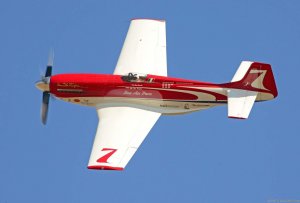 |
| Strega rounding pylon 2 and in the lead during Friday’s Gold Heat. |
#7 Strega, a highly modified P-51D powered by a Rolls-Royce V-1650 Packard Merlin. The engines in both Strega and Voodoo are very similar, and were both built-up for racing by Vintage V-12s of Tehachapi, California. These engines feature the stronger, late model, Allison V-1710 connecting rods, 5.75:1 compression ratio pistons (stock is 6.00:1), low-speed, 0.42:1, reduction gears, and superchargers locked in low-speed, 6.391:1. There are numerous other adjustments and changes within the engines to assure adequate oiling, and to enable running at 3,400-plus rpm, etc. They also use special Grade 160 fuel, with additives, along with ADI (anti-detonate fluid injection) to reduce the temperature of the mixture going to the cylinders as the aftercooler has been removed.
A few years ago Strega was piloted by Steve Hinton, Jr., in which he won Reno in 2009, 2010 and 2012, before switching to Voodoo, in which he won Reno in 2013, 2014 and 2016. Prior to this year, Strega had won the Gold at Reno a total of 14 times, and has become a perennial favorite of many air racing fans. This year, piloted by James Consalvi, who last year piloted Czech Mate, which did not compete in 2017, Strega won all three Gold Heats, Friday, Saturday and the final on Sunday. No small task for a new pilot in a very exotic aircraft. Strega ran well all week, and from the action in its pit, did not appear to be under a lot of stress.
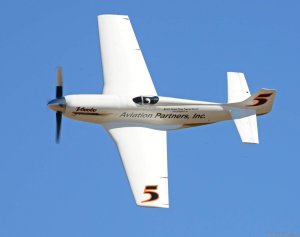 |
| Steve Hinton bringing Voodoo around pylon #2 while leading Sundays Gold Race. Note the oil stain, due to blowby, exiting from the port on the trailing edge of the wing root faring. Interestingly, during each day’s heat race the amount of oil on the fuselage reduced on each lap, heavy early on (as above), much lighter by the end. |
#5 Voodoo, is the other highly modified P-51D powered by a Packard built Rolls-Royce Merlin, also prepared by Vintage V-12s (see above). Pilot Steven Hinton, Jr., crew, and Voodoo spent much of August and the first part of September at Clarks Field (owned by a sponsor of the Voodoo record attempt) in a remote part of central Idaho, where they successfully established a new FAI World Record for a piston driven propeller aircraft at 531.53 mph. This being the average of four passes through the 3 km course, the fastest of which was clocked at 554.69 mph! Joe Clark, a major sponsor of the Voodoo record attempt and a Seattle, Washington industrialist (who heads Aviation Partners, Inc.), was very important to the record attempt, as his company designed Voodoo’s reshaped wing, raising the P-51’s critical Mach number from 0.72 to 0.76.
That effort was not without tribulation! When they first installed the “record” engine, they found that one cylinder was down on compression. After investigation and removal of the cylinder bank, it was found that the shop had used a “chrome” plated cylinder liner, which was then fitted with a piston having a “chrome” faced oil ring. Chrome does not like to run on chrome, and the result was considerable combustion gas bypassing the rings. This was repaired and the engine prepped for the upcoming record run.
Their first attempt at the record was short lived, as when Steve brought the power up to enter the course on August 29, there was a sudden and violent backfire, following which he declared a Mayday and quickly brought Voodoo back to the airport. This time the problem was found to be a bad intake valve seat, ascribed to the head having previously had a weld repair and the seat working loose due to the head not having been properly retorqued following re-installation and run-in. The repair involved flying the bank back to Tehachapi, working all night, and then flying it back to Idaho. Subsequent installation, system checks and testing resulted in all being ready for a second record attempt on September 2, 2017.
The previous 3 km record for piston driven propeller airplanes was held by Lyle Shelton in Rare Bear, set in 1989 at 528.31 mph. To establish a new FIA record requires exceeding the old record by 1%, i.e., 5.28 mph, or >533.59 mph in this case. However, some years ago the FIA canceled the old records for a new approach that uses GPS to establish position and altitude, and a wide range of weight classes. On the day of the record attempt Voodoo was weighed, with pilot and equipment, at 9,748 pounds, placing the effort in the FIA Class C-1e (6,614 < 13,228 pounds), where the existing record was established a few years ago by Reno racer Will Whiteside in his Yak-11 Steadfast at 318 mph.
It had been recommended to Steve that he set full power on the engine and not back off on the turns. As such, he made his first, of four, passes at a speed of 554.69 mph, the second at 527.34, the third at 528.48, and the final pass at 515.62 mph. Clearly the engine was going away, the breathers were blowing oil, indicating that the rings were not able to hold the combustion gas pressure, so more and more power was being lost on every pass. Even so, he hung in there and the Merlin lasted the 15 minutes needed to get into the air and back on the ground. The average speed, and new FIA Class C-1e record was established at 531.53 mph (855.415 km/hr), which is greater than the previous record by Rare Bear, but not by the hoped for 1%. Note: Engine speed was held to 3,400 rpm or less to keep the propeller tips subsonic at the record speeds. This restriction was not continued during race week as race speeds were well under 550 mph, allowing about 3,450 rpm for Voodoo, and up to 3,550 rpm for Strega.
The team was disappointed in not exceeding 533.59 mph, and considered installing the spare engine and making another attempt. The engine was changed, and plans made, however the late summer west coast forest fires in Oregon and Washington caused considerable smoke in the Idaho valley and it was deemed unsafe to make another attempt at the record. With that, the team packed up and flew Voodoo to Reno for this year’s races.
Once safely at Reno’s Stead Field the team began a systematic effort to resolve a number of issues with the backup engine. They first went through the whole installation, making sure everything was connected and installed correctly, but there were still mixture (rich running) and ADI flow issues. However, the issues were not all resolved by the time Steve qualified Voodoo on Tuesday, at 479.364 mph. The team continued to make adjustments and improvements, but on Saturday night they decided to install the leaner carburetor from the record engine. For the Sunday Gold Final things were working well.
Finally, the Sunday Gold Final! Voodoo was out in front, while Strega jockeyed for position through the first seven laps.Then, on the last half of the last lap, Voodoo went high and outside to pass lapped traffic, while Strega went around the traffic on the inside and Steve was passed; upcoming traffic then prevented him from positioning to retake the lead. What a race!
Still the gremlins were at work. During the race Steve was unable to get expected manifold pressure from the engine, which obviously resulted in lower power, even at 3,450 rpm. After crossing the finishing line, and following his cooldown, Steve followed Strega in to land in front of the crowd. However, the engine quit during his landing rollout! He was able to pull onto an adjacent taxiway, and there had to await a tow back to the pits; and of course, he missed the post-race ceremony. The problem was found to be that the gasket between the carburetor and engine had blown-out, and at idle power, the engine would not run. This also may have been the source of the low manifold pressure during the race. At race power the carburetor butterflies are wide open, delivering pressurized ram air that is well above ambient air pressure, i.e., the leaking gasket/loose carburetor was spilling air from the carburetor needed to make manifold pressure, and horsepower.
While at Reno, Voodoo’s owner Bob Button announced that he was retiring the racer to a museum – specifically, the Planes of Fame Museum in Chino, California, home of the Hintons.
#8 Dreadnought, a Sea Fury T.Mk.20, re-powered with a Pratt & Whitney R-4360, piloted this year by Joel Swager. This big and heavy airplane takes the approach of being pretty, and very dependable. As a result Dreadnought often finishes in the money when one or more of the leaders have problems. Back in 1986 Dreadnought set a new qualifying record at 452.737 mph, so qualifying at 422.536 mph, and well below last year’s 440.432 mph, does not show the full potential of the racer, but was probably smart given that Strega and Voodoo were running at 480 mph. Even so, this year’s Gold Heat, running at 419.760 mph, was probably the first time that Dreadnought has been lapped, and right at the finish line.
#71 Sawbones, flown by Shuttle Astronaut Curt Brown, was again the only Wright R-3350-26WA powered Sea Fury at the races this year. Curt qualified at 406.546 mph, down from last year, which was 421.318 mph. He also raced at about 412 mph, which gave him an untested forth place finish in each of the three days of racing.
#114 Argonaut, a Pratt & Whitney R-2800-CB3 powered single seat Sea Fury FB Mk.11 flown by Sherm Smoot. He qualified at 375.597 mph, down from last year’s 383.488 mph, which put him into the Gold Heats for the balance of the week. He finished in 5th place in all of his races.
#924G is a two-seat T.Mk.20 Sea Fury, powered by a rare Bristol Centaurus 18-cylinder sleeve valve engine. This year it was flown by Mark Watt, who qualified the racer at 358.916 mph, down from last year’s qualifying speed of 386.154 mph. Even so, with this qualifying speed he was able to finish first in both the Thursday and Friday Silver Heats, thereby qualifying to bump up into the Gold Heats for Saturday and Sunday. There he finished in 6th place. Probably not a bad idea as there was no way the engine/airplane combination was going to be able to challenge any of the other Gold racers.
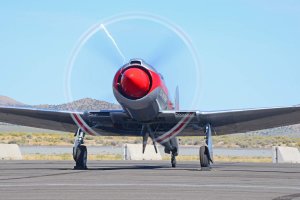 |
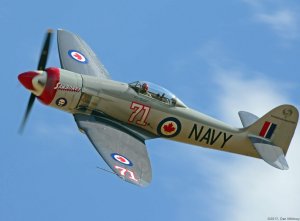 |
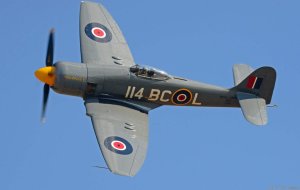 |
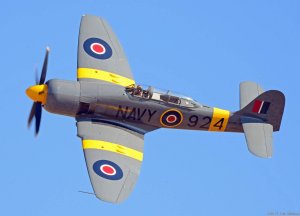 |
| Joel Swager running up the big R-4360 in Dreadnought in preparation for his qualification run on Wednesday, which he did at 422.536 mph. | Shuttle Astronaut Curt Brown flying the big R-3350 powered single seat Sea Fury Sawbones. | Argonaut has been fitted with the classic P&W R-2800 rather than the rare Bristol Centaurus. Though not as big an engine as the more typical Wright R-3350, the Sea Fury airframes are identical, and even without the extra power, Argonaut is able to reliably and consistently stay with the Wright powered racers. | #924G is a classic Bristol Centaurus powered Sea Fury TMK 20 and is seldom seen in the States these days. This photo was taken during the Sunday Gold Final where pilot Mark Watts finished 6th. |
#0 Wee Willy, now a stock P-51D Mustang, this airplane carries the registration number of the famous Red Barron, the Rolls-Royce Griffon powered P-51 that at one time held the propeller driven world speed record. The aircraft was provided by the Planes of Fame Air Museum and was again flown by Robert Patterson. He qualified at 351.266 mph, then finished in second place in the Silver Heats on Thursday, Friday and Saturday, and won the final Silver Heat on Sunday at 337.310 mph.
#14 Spam Can, a stock P-51D Mustang also provided by the Planes of Fame Museum, was flown by John Maloney. You may remember that John flew #14 last year too, however that was the museum’s Allison powered P-51A. John qualified this year at 334.522 mph, compared to 356.032 mph in the “A” model last year. Miss Virginia, the P-51A, is faster than the P-51D at low altitudes! John’s race speeds were slightly better on Saturday and Sunday when he finished third and second in the Silver Heats with speeds of 335.072 and 335.506 mph respectively, finishing the heats just behind his stable mate Wee Willy II.
#44 Sparky/Blondie, is another stock Rolls-Royce Merlin powered P-51D, and flown by Brant Seghetti. Brant qualified his racer at 329.106 mph, down from the 343.195 mph posted last year, but better than his 2015 qualifying speed of 310.362 mph, and much like his 2014 speed of 329.638 mph.
Brant raced in the Silver heats all week with Sparky/Blondie finishing in fifth and sixth places.
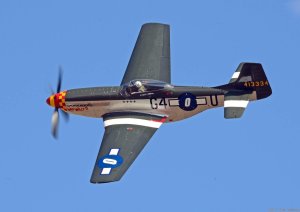 |
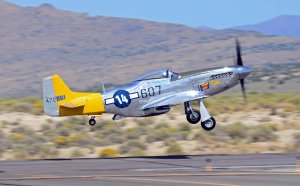 |
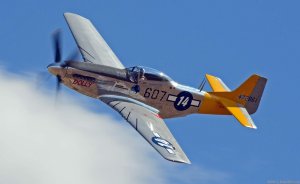 |
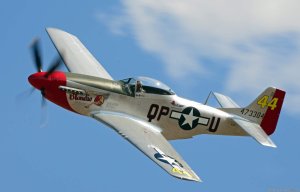 |
| Wee Willy, a stock P-51D piloted by Bob Patterson coming around pylon 2 in Friday’s Silver Heat. | #14 Spam Can leads a double life, as on the other side its Dolly, a P-51D from the Planes of Fame piloted by John Maloney. He qualified at 334.522 mph and the finished 2nd in the Sunday Silver Final at 335.506 mph. | The Dolly side of #14 Spam Can, a P-51D from the Planes of Fame piloted by John Maloney. | P-51D Blondi (Sparky on the off-side), during the Thursday Silver Heat. Piloted by Brant Seghetti, who finished in fifth place at 298.386 mph. |
#31 Speedball Alice, a stock Merlin powered P-51D was qualified and raced by Dan Vance. His qualifying speed was 319.509 mph, which placed him in the Silver Heats all week. He was quite competitive with the other stock Mustangs, trading positions during the heats and at the finish. His best finish was third place on Thursday at 317.783 mph, and then on Sunday when he edged out Sparky/Blondie for fourth place.
#22 Little Horse, a stock Merlin powered P-51D new to the Reno scene and provided by Texas Flying Legends Museum. The airplane was qualified by Alan Miller at 302.262 mph; however he became ill and missed the Thursday Bronze Heat. Mark Murphy replaced him in the Friday Bronze Heat, wherein he finished in sixth place at 266.755 mph. Alan recovered and took over the piloting duties for the Saturday and Sunday races, in fact winning the Sunday Bronze race at 312.131 mph.
#6 Shanty Irish, just came out of an extensive restoration as an Allison powered P-51A. This airplane has previously competed in a number of Reno Air Races as Jerry Gabe’s P-51A Polar Bear. The airplane now looks nothing like it did previously. Its story involves having crashed in Alaska during WWII, then recovered and extensively restored, although using a lot of P-51D components in the wing and fuselage. To their credit, the John Muszala’s Pacific Fighters in Idaho has done a complete restoration to P-51A standards. This involved building an entirely new “dog house” assembly for the cooling radiators, one that has the moveable air intake scoop. There is also a lot of new sheet metal and serious corrosion issues have been resolved. The result is a beautiful racer flown by John Musszala II
John qualified at 301.334 mph, using 3,000 rpm and 45 inHgA. This put him in the Bronze Heat on Thursday, where he finished second and followed that up by winning the Friday Bronze Heat at 311.792 mph. With this win he bumped up to the Silver Heat for Saturday and Sunday, finishing there in fourth and third, with speeds of 323.856 and 319.644 mph respectively.
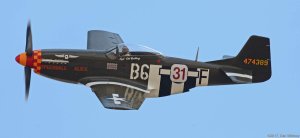 |
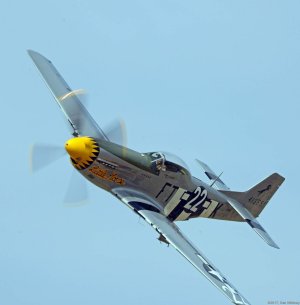 |
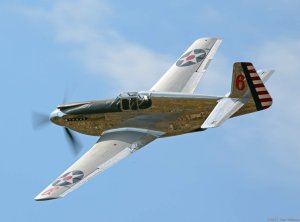 |
| #31 Speedball Alice is another stock Merlin powered P-51D and piloted by Dan Vance. Shown here during Friday’s Silver heat, where he finished in fourth place at 323.152 mph. | #22 Little Horse, a stock Mustang from the Texas Flying Legends Museum, shown here winning Sunday’s Bronze heat at 312.131 mph. | #6 Shanty Irish, a stock Allison powered P-51A piloted by John Muszala II during Friday’s Bronze heat, which he won at 311.792 mph. Note the reflection of the desert on the polished fuselage. The airplane is finished as the historic XP-51A. |
#62 Bunny, another stock Merlin powered P-51D new to the Reno scene and provided by the Palm Springs Air Museum. The airplane was qualified by Mark Moodie at 300.147 mph. Racing in the Bronze Heats, he finished third, second and first, at 306.655 mph, on Thursday, Friday and Saturday respectively. With the win he bumped up to the Silver Heat for the Sunday final, placing sixth at 304.018 mph.
#85 Whistling Death, a FG-1D Corsair from the Texas Flying Legends Museum, flown by Michael Schiffer. He qualified at 299.938 mph, thus earning a spot in the Bronze Heats. There he finished seventh, sixth and second in the Friday, Saturday and Sunday races. His Sunday finish was a respectable 308.693 mph. It was really good to see the unique and big fighter on the course.
#41 Martlet, a stock FM-2 Wildcat from the American Airpower Heritage Flying Museum, flown by Michael Pfleger. He qualified at 292.189 mph, thus earning a spot in the Bronze Heats. He raced well, finishing fourth, third, second and third on the four days of racing. Every race was steady at about 281 mph, though he pulled out a 286.642 mph for the final. Standing out on the pylons it was fun to hear and see the big Wright R-1820-76 radial coming into the turns.
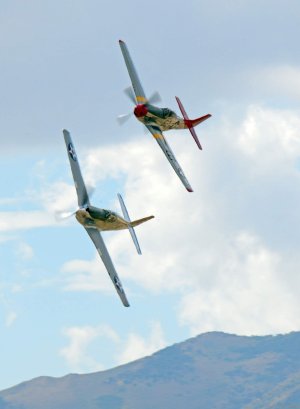 |
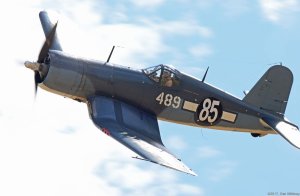 |
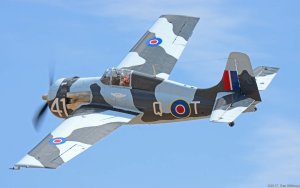 |
| #6 Shanty Irish, the P-51A Mustang, leading #62 Bunny, a stock P-51D Mustang, during the Friday Bronze heat where they finish first and second respectively. | #85 Whistling Death, a P&W R-2800 powered FG-1D Corsair, piloted by Michael Schiffer during Thursday’s Bronze heat, rounding pylon #8 and heading for the home pylon. | #41 Martlet, a Wright R-1820 powered FM-2 Wildcat, piloted by Michael Pfleger during Thursday’s Bronze heat, where he finished in fourth place at 281.227 mph. |
#42 Texas Warhawk, a stock P-40E from the Texas Flying Legends Museum, flown by Bernie Vasquez. He qualified at 291.809 mph, thus qualifying for the Bronze Heats. He was a steady racer, finishing fifth twice, third once and fourth in the final on Sunday, where he posted his best race speed of 270.493 mph.
#84 Normandy Spit, a stock Spitfire Mk. IXc from the Texas Flying Legends Museum, flown by Warren Pietsch. He qualified at 288.735 mph, thus racing in the Bronze Heats. He finished sixth on Thursday, fourth on Friday and Saturday, and fifth in Sunday’s final. His best speed was on Sunday at 270.363 mph.
 |
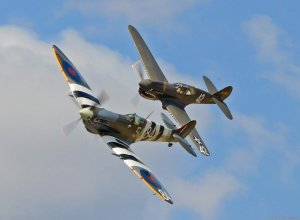 |
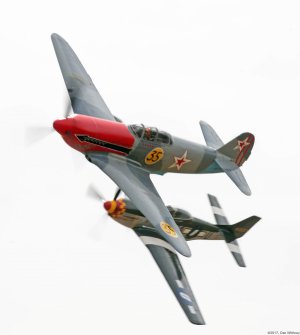 |
| #42 Texas Warhawk, an Allison V-1710 powered Curtiss P-40E, piloted by Bernie Vasquez during Friday’s Bronze heat, rounding pylon #8. He finished fifth in the heat at 267.649 mph. | #84 Normandy Spit, the Spitfire, leads stable mate #42 Texas Warhawk coming around pylon #8 during Friday’s Bronze heat where they finished 4th and 5th with speeds of 267.810 and 267.649 mph respectively. | #35 Full Noise, a Yak 3M, leads P-51D #0 Wee Willie II around pylon #2 during Saturday’s Silver heat where they finished 1st and 2nd, the winning speed for Full Noise was 345.277 mph. |
#35 Full Noise, an Allison V-1710 powered Yakovlev 3M brought from New Zealand just for the races by owner/pilot Graeme Frew. He received “No Time” for qualifying, as during his warm-up and practice laps on Tuesday morning things did not go well with his race engine and he had to bring it in. It appeared that he had a burned piston. Even so, he was able to reinstall his original engine and was ready to race in the first Bronze Heat on Thursday. Starting from last place, he moved to the front and won with a speed of 308.895 mph! Good going Graeme!
With this win he bumped up to the Silver Heat on Friday, where he placed fifth with a speed of 319.885 mph. On Saturday he again raced in the Silver Heat, this time winning with a speed of 345.277 mph! He then again bumped up, and was the seventh airplane in the Sunday Gold Race, where he finished seventh with a speed of 325.491 mph, having been lapped twice by Voodoo and Strega.
Graeme Frew went to considerable trouble to compete in this year’s races. He lives in New Zealand, where he operates his Yak. He disassembled and shipped the airplane to Southern California, where it was reassembled and the race engine installed. His effort was co-sponsored by Joe Yancy Enterprises, who provided the special “race” prepared V-1710 for the contest. While not a lot is known about this engine, it was based on a V-1710-111, though the supercharger gears had been changed from the stock 8.10:1 to 8.80:1. This would provide a higher manifold pressure for the racer [about 60 inHgA when running at 3,000 rpm versus 54 inHgA for a stock V-1710-111 at Reno’s field elevation and 300 mph], and should have made it more competitive. (Note, an inch of manifold pressure is worth about 25 horsepower, so with the extra six inches of manifold pressure the normal 1,450 horsepower output of a V-1710-111 would have been increased by about 150 horsepower.)
A late style supercharger impeller inducer with elliptically curved blades, intended to improve airflow into the impeller, was also installed. Other changes involved installing Allison G-6 pistons [6.00:1], that had been dished, and shimming the cylinder banks by about 0.020 inches to further lower the compression ratio, which he estimated to be 5.75:1 instead of the standard 6.65:1. [Rather, a detailed calculation shows that “lifting” the banks by 0.020 inches and fitting the G-6 pistons in a V-1710-111 cylinder head, with its smaller combustion chamber than in the V-1710-G6, results in a 5.68:1 compression ratio]. The lower compression ratio did not increase output of the modified engine, so the hoped for extra 150 horsepower was an exaggeration [see box]. The engine did not have water injection (ADI), nor was it required.
Upon arriving at Stead Field, site of the Reno Air Races, Full Noise showed considerable soot on the cowling, pointing to leaking rings and burning oil. It was said that the “rings were still seating,” which may have been a factor, however the rings were the stock Allison “Keystone” rings, which were not good when they were all that was available. Still, all was “go” and Graeme went out on Monday to do his high “g” practice runs. Although he had intended to qualify running at 3,100 rpm [to make more manifold pressure], he never got over 2,800 rpm and 46 inHgA when the engine began running rough and he came in, pouring smoke from a couple of cylinders. It sure looked like detonation was occurring and several pistons were badly damaged. The race engine was done.
Graeme’s crew then put in an all-niter and changed back to the stock engine that had been in the airplane when it arrived in California. He had some 125 hours on this one, which was originally a V-1710-99, though he believes it is fitted with 8.10:1 supercharger gears and is able to develop about 55 inHgA, about 1,450 horsepower.
From this disappointing start Graeme went on to have quite a week! Since he had not been able to record a qualifying time he had to start from last place in Thursday’s Bronze Heat. From there he managed to pass all of the other racers during the race, including two of them twice, finishing first with a speed of 308.895 mph. Not bad for a Reno Rookie, and in his first race! With the win he was able to bump up into the Friday Silver Heat, where he finished fifth with a speed of 319.885 mph. Then on Saturday, again in the Silver, he made 345.277 mph and came in first, which allowed Full Noise to move up to the prestigious Sunday Gold Final! There was no way Full Noise could challenge Strega and Voodoo, or the other big guys, so Graeme settled for last place; having one of the best seats in the house, while getting twice passed by the leaders. His posted speed for the Gold Final was 315.769 mph, but included a sixteen second penalty for a pylon cut; without the cut he flew at 325.491 mph.
Benefit of Reducing Compression Ratio
Assuming a 5.75 compression ratio, compared to a V-1710-111 with 6.65:1 CR, the lower CR allows a greater mass of mixture into the cylinder, which increases the BHP from about 1,571 to 1,618 at 3,000 rpm and 60 inHgA. However, it is not all gain, as the lower compression ratio also lowers the peak and average pressures acting on the piston. The lower CR reduces peak pressure from about 1,160 psi to 1,038 psi, a nearly 14% drop, with the result that net horsepower is reduced to 1,384 BHP, a loss of about 234 BHP, about the same as losing 9 inHgA manifold pressure in a stock engine. The only reason lower CR pistons are used in the racing Merlin is it reduces the loads on the crankshaft bearings, i.e., it’s not making full power; reliability has a price.
 |
| The noses of the four Texas Flying Legends Museum racers lined up on the ramp before the daily airshow. |
The Airshow
This year the Reno Race Committee was not able to schedule one of the major jet demonstration teams; however they came up with an entertaining and capable replacement in the form of the Texas Flying Legends Museum. The museum brought six vintage WWII aircraft, led by their B-25 Betty’s Dream, their TBM Avenger and supported by a Mustang, P-40 Warhawk, Corsair and Spitfire. The last four also participated as racers; which required some quick turnarounds from racing to launch for the Airshow. The show included music, narrative, a lot of close passes, and a fair amount of fireworks during the simulated battles.
The Other Racing Classes
While our emphasis is on the Unlimited Class and Warbirds at Reno, there is a lot of other racing going on as well. The Jet Class, Sports Class, T-6 Class, Biplanes and Formula One Classes all have a full race schedule, with racing starting at eight in the morning and continuing until about five in the afternoon. In total, there were 131 racers from all classes, with 132 last year, which was an increase over the year before. Racing is alive and well at Reno!
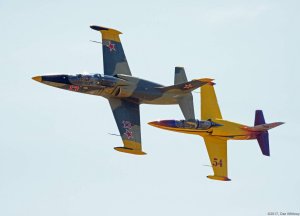 |
 |
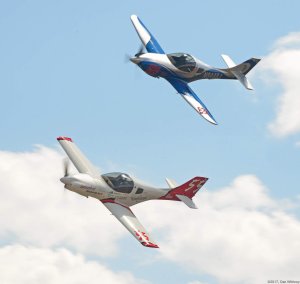 |
| This year there were 18 jet racers. This included eleven L-39s, three L-29s, two Vampires and two Galeb G2s. Again this year Rick Vandam, from Reno, NV, brought home the Gold with his win in the L-39C #5, American Spirit, with a speed of 494.210 mph. All jets pictured here are L- 39s. #5 (right) has modified wing tips and elevator to go faster. | Sport Class racing is very diversified, with 40 entrants in airplanes covering a wide range of types and setups, but all having engines under 1,000 cubic inches displacement, with some being turbosupercharged, having ADI, and some even have nitrous oxide injection. Many are homebuilt. Speeds range from 200 to over 400 mph! As a result the racers break into Gold, Silver, Bronze and Medallion pairings for the races. Consequently there is some very good competition in the Class. Jeff LaVelle won the Gold again this year in his #39 Super Glasair III with a speed of 388.313 mph. | |
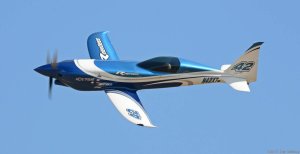 |
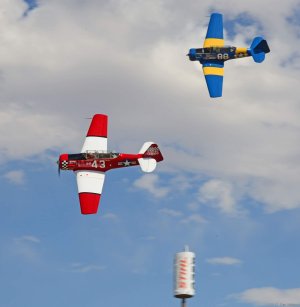 |
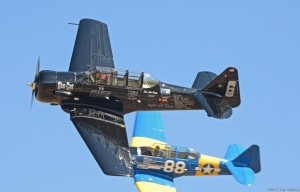 |
| Kevin Eldredge in his NXT racer #42 Relentless. Qualified at 319.639 mph. | In the Thursday Silver T-6 Heat, #43 Midnight Miss III, who finished 3rd at 222.209 mph, is racing #88 Radial Velocity, who finished in second place at 225.211 mph. The T-6 class has a lot of close and exciting racing. #6 Six Cat, right, won the heat at 227.601 mph. | |
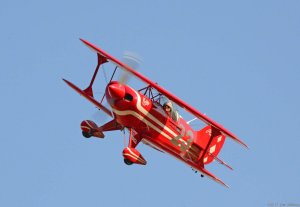 |
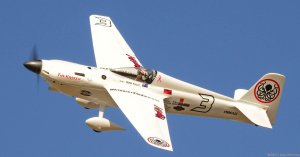 |
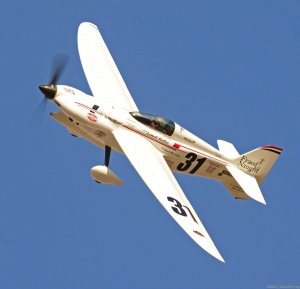 |
| #23 Miss Oyl, a Pitts S11C piloted by Scott Thomson, qualified at 153.130 mph, and shown here in Friday’s Silver Heat where he finished in 5th place at 150.278 mph. Sunday’s Gold final Biplane race was won by Phantom, a modified Mong Sport, piloted this year by Andrew Buehler, with a speed of 226.725 mph. | Formula One racer #3 The Kraken finished 7th in Sunday’s Gold Final at 210.205 mph. | Sunday’s Gold Final race was won by Lowell Slatter in #31 Fraed Naught at a speed of 242.104 mph. |
Summary
With the exception of Strega and Voodoo, it appeared that all of the racers intended to fly home with what they brought, i.e., no one wanted to break their planes or engines. So other than for the above two, the speeds were down across the board. However, no one noticed!
It was exciting to see the variety of aircraft types out on the course and in the pits. They all were in beautiful shape and sounded great, and coming around the pylons you can’t tell if they are doing 280 mph or 380 mph. When Strega and Voodoo come by at 480 mph you can tell the difference, however, its fun to see them passing the slower airplanes.
All in all, the racers this year put on a great show. And that final finish between Strega and Voodoo is one for the memory banks! Thanks racers!
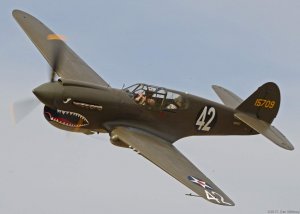 |
| Bernie Vasquez waving to photographers and the crowd as he rounds pylon 8 during Sunday’s Unlimited Bronze final. |
See you at Reno 2018
| Race No. | Name | Aircraft Type | Pilot | 2017 Qualifying mph |
Thursday mph |
Friday mph |
Saturday mph |
Sunday mph |
|---|---|---|---|---|---|---|---|---|
| 7 | Strega | P-51D Mustang-Modified | Consalvi, James | 484.724 | BYE | 487.892-G1 | 479.124-G1 | 481.340-G1 |
| 5 | Voodoo | P-51D Mustang-Modified | Hinton, Steven Jr. | 479.364 | BYE | 476.990-G2 | 467.423-G2 | 480.744-G2 |
| 8 | Dreadnought | Hawker TMK20 Sea Fury/R-4360 | Swager, Joel | 422.536 | BYE | 418.716-G3 | 417.313-G3 | 419.760-G3 |
| 71 | Sawbones | Hawker FB11 Sea Fury/R-3350 | Brown, Curt | 406.546 | BYE | 413.905-G4 | 408.326-G4 | 411.100-G4 |
| 114 | Argonaut | Hawker Mk 11 Sea Fury/R-2800 | Smoot, Sherman | 375.597 | BYE | 374.531-G5 | 367.900-G5 | 371.222-G5 |
| 924 | #924G | Hawker TMK20 Sea Fury/Centaurus | Watt, Mark | 358.916 | 360.479-S1 | 358.784-S1 | 354.363-G6 | 348.698-G6 |
| 0 | Wee Willy II | P-51D Mustang | Patterson, Robert | 351.266 | 336.377-S2 | 357.420-S2 | 344.185-S2 | 337.310-S1 |
| 14 | Spam Can/Dolly | P-51D Mustang | Maloney, John | 334.522 | 315.700-S4 | 324.921-S3 | 335.072-S3 | 335.506-S2 |
| 44 | Sparky/Blondie | P-51D Mustang | Seghetti, Brant | 329.106 | 298.386-S5 | 301.952-S6 | 311.287-S6 | 312.145-S5 |
| 31 | Speedball Alice | P-51D Mustang | Vance, Dan | 319.509 | 317.783-S3 | 323.152-S4 | 315.346-S5 | 312.494-S4 |
| 22 | Little Horse | P-51D Mustang | Miller, Alan² /Murphy, Mark | 302.262 | DNS-S6 | 266.755-B6 | 267.192-B5 | 312.131-B1 |
| 6 | Shanty Irish | P-51A Mustang | Muszala, John, II | 301.334 | 305.998-B2 | 311.792-B1 | 323.856-S4 | 319.644-S3 |
| 62 | Bunny | P-51D Mustang | Moodie, Mark | 300.147 | 288.152-B3³ | 305.859-B2 | 306.655-B1 | 304.018-S6 |
| 85 | Whistling Death | FG-1D Corsair | Schiffer, Michael | 299.938 | DNF-B7 | 264.526-B7 | 266.519-B6 | 308.693-B2 |
| 41 | Martlet | FM-2 Wildcat | Pfleger, Michael | 292.189 | 281.227-B4 | 280.678-B3 | 282.210-B2 | 286.642-B3 |
| 42 | Texas Warhawk | P-40E | Vasquez, Bernie | 291.809 | 255.567-B5 | 267.649-B5 | 267.527-B3 | 270.493-B4 |
| 84 | Normandy Spit | Spitfire Mk. IXc | Pietsch, Warren | 288.735 | 254.045-B6 | 267.810-B4 | 267.516-B4 | 270.363-B5 |
| 35 | Full Noise | Yakovlev 3M | Frew, Graeme | No Time | 308.895-B1 | 319.885-S5 | 345.277-S1 | 325.491-G7¹ |
|
M = Medallion, B = Bronze Heat Race, S = Silver Heat Race, G = Gold Heat Race, DNS = Did Not Start, DNF-# = Did Not Finish-lap out, DNQ = Did Not Qualify, DNR = Did Not Race, DQ = Disqualified, BOLD = 1st Place Heat Winners, Number following Heat letter is finishing position 1 Penalized 16 sec for pylon cut, scored at 315.769 mph 2 Developed case of food poisoning and Mark Murphy replaced him for Friday race 3 Penalized 36 seconds, actually finished in apparent second place with speed of 306.976 mph | ||||||||
Send mail to
![]() with questions or comments about this web site.
with questions or comments about this web site.